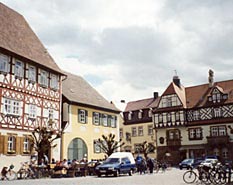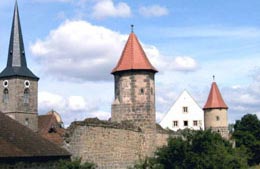|
|
 |
 |
 |
|
 Sesslach Sesslach
City Fortification |
|
The almost 300 metres long moat extends to the so-called "Geyersberg gate”. For a long time it was assumed that this moat was filled with water. But it wasn’t. The moat only was constructed to hold up offenders. In this section the city wall still has its original height of almost ten metres. Here three small original towers still exist.
|
|
 |
|
|
|
 |
|
Especially the chunks, which are piled up on the wall, are remarkable. On the one hand they were used as brickbats and on the other hand to prevent enemies from erecting scaling ladders.
Towards Geyersberg, the wall becomes lower. This is the result of fire in 1848. The upper brick range was carried off to apply and fix the ends of the roof battens of the new built houses.
In the 19th century the walks along the battlements disappeared. First of all they had lost their need, and secondly people began to build their houses directly at the wall or integrated their houses in the city wall.
|
|
|
|
|
|
|

|
|
|
|
Local History of Sesslach |
|
In the year 800 Sesslach is first proved by documents as "Duo Sezelaha”. Count Assis, a descendant of Karl dem Großen (Charlemagne), left his whole property to the Fulda monastery.
1244: Destruction of Sesslach during the battle between Duke Otto VIII of Meran (Count of Plassenburg castle) and the bishop of Wuerzburg Hermann I of Lobdeburg.
In 1335 Emperor Ludwig der Bayer (the Bavarian) granted municipal law, including market law and the right to brew beer. In the following years Sesslach became fortified and administrative centre with market, church and court.
1640: Conquest of Sesslach by imperial troops: pillage, plundering, six dead and many injured persons.
 |
|








